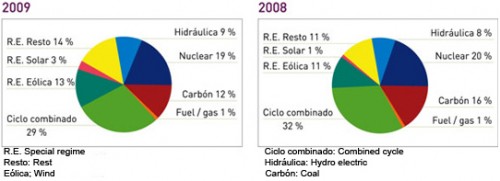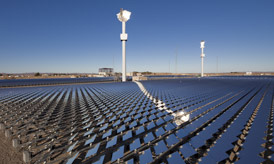
Humanity needs to move rapidly towards 100% renewable sources of power over the next couple of decades. I find the achievement of the Spanish electricity industry over the last 5 or 6 years truly remarkable and in many ways a model we all should follow. The 2 graphs show the changes over a single year, from 2008 to 2009. The recession, rather than efficiency gains, seems to be the cause of a 4.3% drop in demand. Together the fall in demand and the increasing share coming from renewables caused a 17% reduction in Co2 emissions in a single year. (The graphs and figures come from Chris Goodalls’ excellent carbon commentary website)
Spain has had a system of feed-in tariffs which has provided the financial security necessary for major new investments. This has allowed the rapid construction of many renewable energy systems, providing knowledge that will be invaluable in the transition to a low carbon economy and many new jobs at a time of recession. Wind provided 13% of the total and the Spanish grid managed to accommodate wind speed fluctuations, proving the wind sceptics wrong.
It is the solar sector, which is still only 3% of the total, I find most inspiring. It has grown very rapidly from nothing in a few years. Spain is now the world leader in Concentrating Solar Power (csp). Since the PS10 power tower opened in March 2007 the Spanish have opened half a dozen csp units with a total capacity of 237 Mw, but what is even more impressive is the fact that they’ve another 29 currently under construction with a combined capacity of 1982 Mw (List of solar thermal power stations, wikipedia), which to give it a sense of scale is almost the same as our huge Ratcliffe-on-Soar dirty coal power station in Nottinghamshire.
It’s my belief that concentrating solar will be one of humanity’s main power sources in future, so let’s raise a glass and toast the Spanish for getting on with the job. Next time; what’ll be our main power source in the UK?
Monthly Archives: March 2010
Power Down

(Upsala Glacier, Argentina – once the biggest in South America)People often ask me what must be done to tackle climate change, and why I seem more optimistic than many environmentalists. Basically the answer is that I see many possible solutions to humanities problems. That doesn’t mean the changes necessary for a better future will be easy, or that they will be made, but they are becoming increasingly clear. There is the power-up and power-down sides to this. Today I want to write about the power-down side; next time I’ll try and sum-up my ideas on power-up.
The power-down side is all about using energy and resources less wastefully, so that we in the rich world consume less energy. This falls basically into two areas; behavioural change and technological change. We need both, and yet often the promoters of one path seem to think theirs is the only way. Oliver Tickell in his excellent book Kyoto2 brilliantly shows the connection in the case for carbon taxes acting as a spur for both behavioural and technological change.
Perhaps the best web-site I know that promotes using less energy through technological innovation is the Rocky Mountain Institute. The RMI was founded by Amory & Hunter Lovins back in 1982. Since then they’ve been working with industrial partners to develop lots of exciting technological breakthroughs in three core areas: energy & resources, transport and buildings.
The Transition Towns movement seems typical of many worthy grassroots organisations in Britain who promote a predominantly behavioural change approach. Frustrated by governments inaction they see solutions coming mainly from the community. Transition_Handbook.pdf But while community engagement is excellent, it seldom seems to generate technologically well informed or grounded solutions.
Humanity needs both/and, not either/or: the behavioural and the technological, the community and the professional.
Solar Power

(e-Solar power towers which opened Aug 2009)
The last blog entry was somewhat downbeat as I was writing about the lack of political will to take the required action on climate change. This time I want to write about positive action that is happening now. As we move from “The Fossil-fuel Age” to “The Solar Age” obviously the key industry one might want to look at would be solar power.
In a couple of weeks time the UK will adopt feed-in tariffs for domestic scale renewable energy, and at the generous rate of 41p per kWh for solar pv. Whether or not this is a good use of money is open to debate. Most people associated with the green/ transition movement think this a good thing. I tend to be with George Monbiot on this(click here for his article ‘The German Disease’). We could have spent the money much more wisely and got much greater Co2 savings through other investments. An efficiency revolution in how we use energy in housing, transport and domestic appliances would produce massive energy savings and investment in bigger more cost effective renewables would produce low carbon electricity at a fraction of the cost of pv in a cool cloudy climate like the UK.
However really exciting developments are happening in the world of Solar. In May Algiers is hosting the Maghreb Solar Conference. It is at meetings such as these that the really important investment decisions will be made about developing solar power in the hot arid countries where a huge variety of solar technologies can really work effectively. Follow more about solar power from the worlds deserts on the excellent Desertec website
